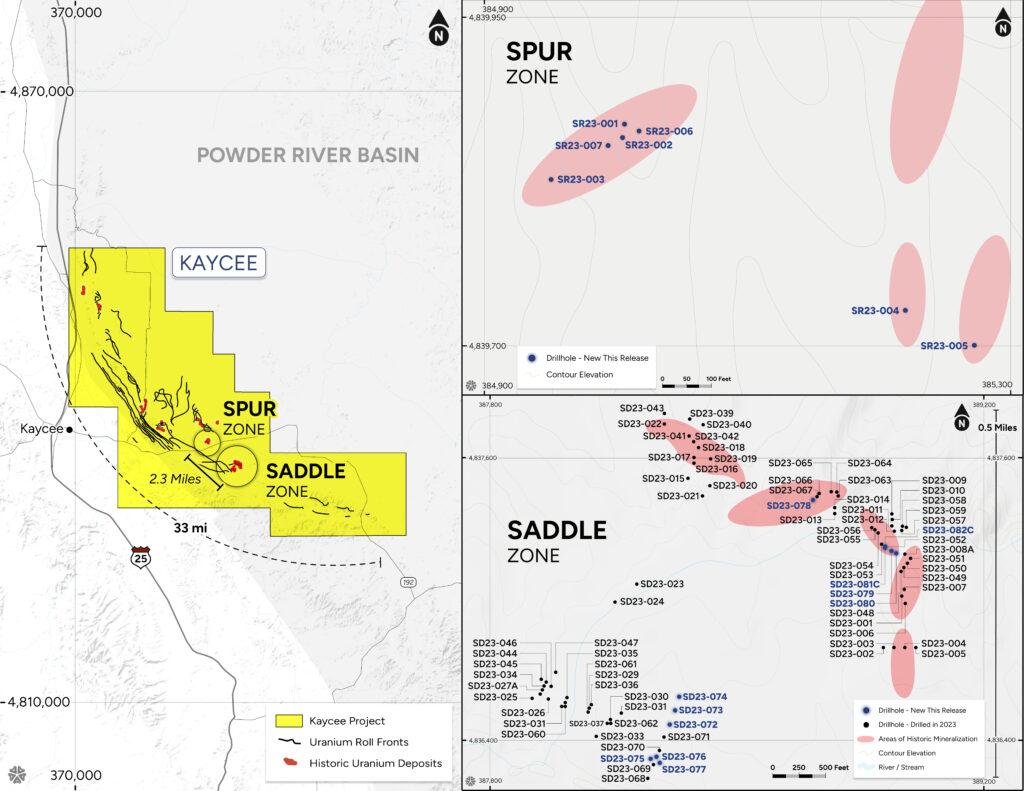Kaycee Uranium Project, Wyoming
Highlights
The Kaycee Project in Wyoming’s Powder River Basin (PRB) is the Company’s priority project, covering a 33 mile mineralized trend with over 110 miles of identified roll fronts and consists of more than 42 square miles of mineral rights. The Kaycee Project is believed to be the only project in the PRB where all three known historically productive sandstone formations (Wasatch, Fort Union and Lance) are mineralized and potentially amenable to ISR extraction. Under Nuclear Fuels Inc., this represents the first time since the early 1980’s that the entire district is controlled by one company.
With over 3,800 drill holes, historic drilling has confirmed uranium mineralization in all three historically productive sandstones within the PRB, occurring over more than 1,000 feet of vertical section. The majority of the trend has not been well-explored with drilling concentrated on approximately 10% of the trend.

Project Details
Nuclear Fuels acquired the Kaycee Project from enCore Energy Corp., which retains a back-in right for 51% of the project by paying 2.5X the exploration costs and carrying the Kaycee project to production (costs recoverable from production) upon Nuclear Fuels establishing a minimum of a 43-101 compliant resource of 15 million pound U3O8. A 200 hole drill program is currently underway.
Wyoming is a proven and prolific uranium producer with a pro-energy government with established regulatory regime for the extraction of uranium through in-situ recovery (ISR) technology. As Wyoming is one of the few “Agreement States” where the federal government and the Nuclear Regulatory Commission have ceded regulatory authority to the state government, permitting and advancing uranium projects is more efficient and streamlined as compared to most other states. Wyoming, with over 250 million pounds of historic production, ranks as the state with the second most uranium production to date; most of which has been through the ISR method since 1990 with most of the ISR production having come from the PRB.

Drill holes are reported that returned significant zones of uranium mineralization with >2 ft thickness at or above a grade cut-off of 0.02 per cent eU3O8 or that are relevant to exploration targeting. (1) %U3O8 by Gamma logging is a measure of gamma intensity from a decay product of uranium. Gamma log assays may be in disequilibrium with ICP-MS assays. Comparisons of U3O8 Gamma log and ICP-MS assays of Powder River Basin core samples indicate that U3O8 Gamma is comparable to ICP-MS uranium assay in the Powder River Basin. (2) Grade Thickness, or GT, is defined as the product of the mineral grade multiplied by the thickness of the mineralization. Bold type represents potentially ISR recoverable uranium with a Grade Thickness of >0.3 which is considered suitable for inclusion in a wellfield.
Spiering, Eugene D., 1983, Geologic Report on the 1983 Mapping Program of the Kaycee Uranium Project: Private Company Report, 79p., 27 pl.
Fruchey, R., A., 1982, Kaycee Geologic Report for Washtenaw Energy Corporation and Midwest Energy Resources Co. Internal report.
Wyoming, America’s Leading In-Situ
Recovery (ISR) State
Highlights
The technical content of this news release has been reviewed and approved by Mark Travis, CPG., a contractor to the Company, and a Qualified Person as defined in National Instrument 43-101.
Drill holes are completed by Single Water Services using a rotary drill rig. Chip samples are collected for lithological logging every five feet. Century Geophysics of Tusla Oklahoma is contracted to conduct downhole gamma ray, resistivity, spontaneous potential, and deviation. Century Geophysics calibrates it’s downhole tools in the US Department of Energy uranium logging Test pits in Casper Wyoming to insure the accuracy of the down hole gamma ray log measurements.




